|
BEIJING (Day 1 - part 4)
This area is considered the outer court and served as the political center. Today it houses several museums.
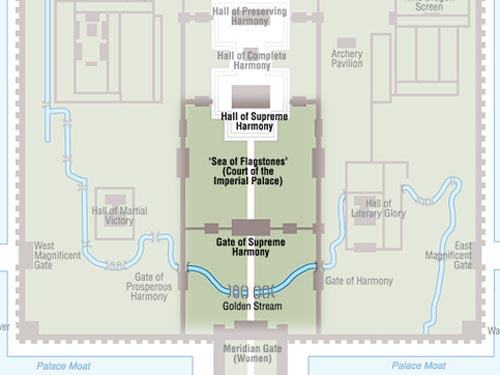
Inner Golden Stream:
After emerging from the Meridian Gate, one can see five bridges in a courtyard. Under these bridges flows the Inner Golden Steam. As usual, the central bridge was used exclusively by the emperor, the two flanking it were for members of the royal family, and the two outer were for court officials.
The Inner Golden Stream bridges were supposed to represent the five virtues preached by Confucius: benevolence, righteousness, rites, intelligence and fidelity. They were arranged as five arrows symbolically aiming to Heaven, because the emperor considered himself the Son of Heaven.
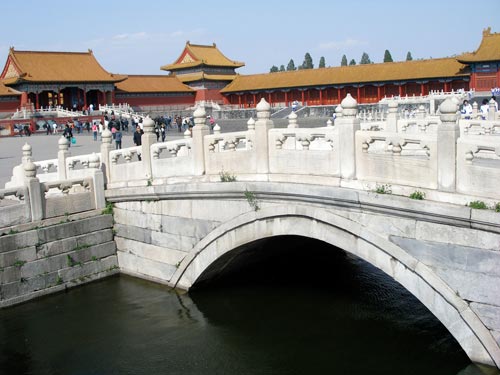
The bridges are made of marble. With the ever-present threat of fire, the river served as a water reservoir as well as being a decorative feature.
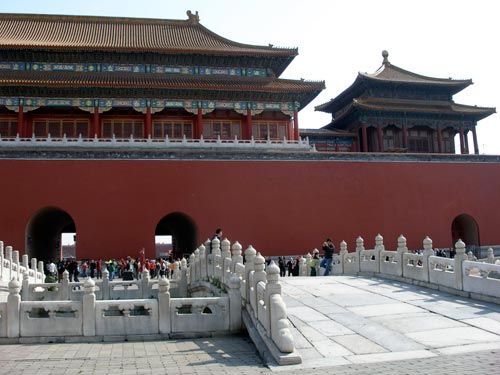
Looking back at the Meridian Gate
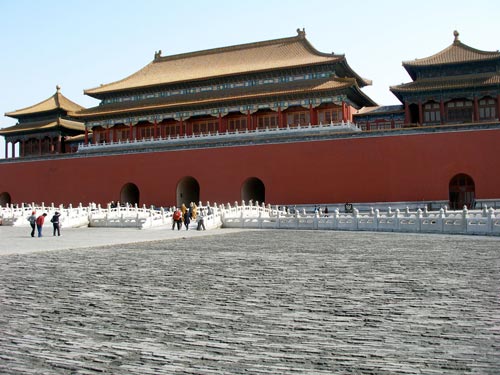
Gate of Supreme Harmony (Taihemen):
During the Ming and early Qing Dynasties, this was where the emperor held his court to handle the state affairs. The emperor would sit in the gateway, accept documents from his ministers, and make the decisions.

Looking from the bridges across the square at the Gate of Supreme Harmony
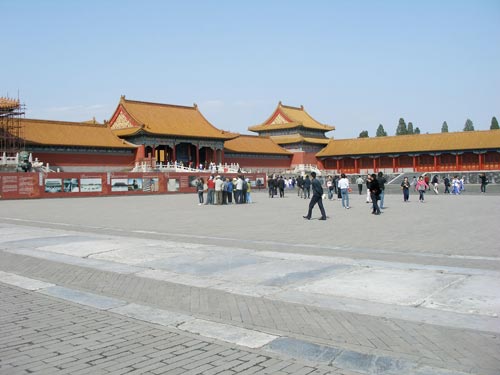
The Tai'he Gate Square covers 100,000 square feet. Since the emperor was regarded as the Son of Heaven, no one and nothing could appear higher... hence no trees.
Even though the city was heavily guarded and surrounded by high walls with watch towers, the emperor had the foundation beneath the courtyard paved with fifteen layers of bricks to prevent potential assassins from digging underground tunnels into the palace.
Gate of Moral Standards:
To the west of the Gate of Supreme Harmony is Zhen Du Men (Gate of Moral Standards). Constructed in 1420, the gate was destroyed by a fire in 1888 but rebuilt a year later. During the Qing Dynasty, it was one of the places where the imperial guards on duty lived. Zhen Du literally means Correcting the Law.
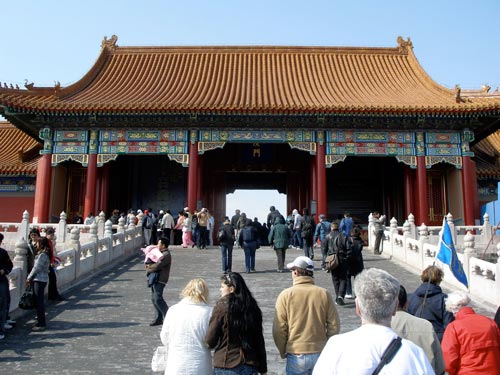
Walking up the ramp to the gate
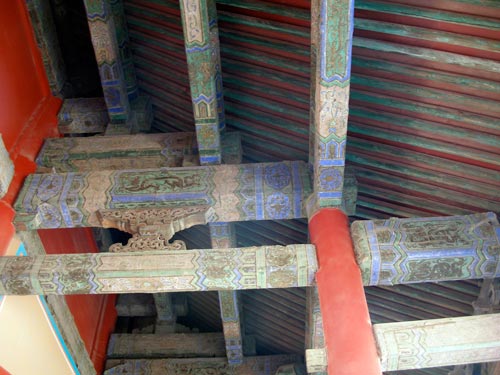
A look up at the rafters
Hall of Supreme Harmony (Taihedian):
The Hall of Supreme Harmony (also called the Throne Hall or Golden Carriage Palace) is the largest hall within the Forbidden City. Built above three levels of marble stone base, the enormous wooden structure rises 115 feet, making it the tallest building in Beijing during the Ming and Qing Dynasties.
It was first built in 1420 but burned down several times. The present hall was rebuilt in 1695. This is where the emperors hosted their grand ceremonies such as enthronements, weddings, new years and military dispatchments.
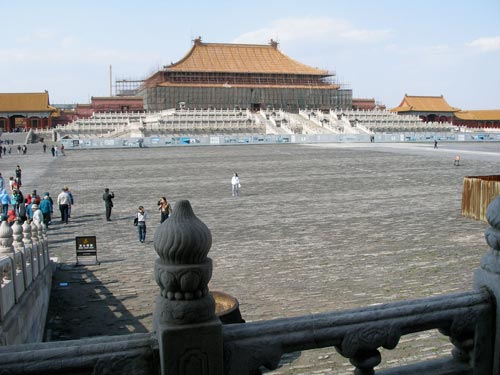
Our view of the hall as we emerge from the gate. Unfortunately it was covered with scaffolding.
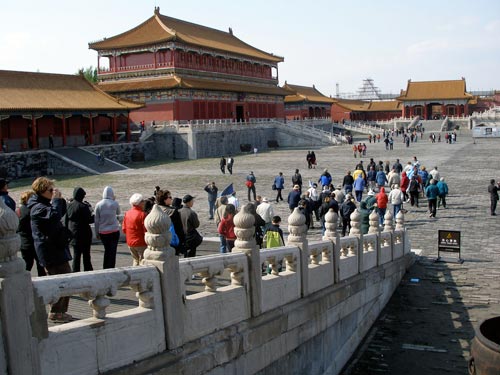
To the left is Hong Yi Ge (the Tower of Enhanced Righteousness).. The tower was constructed in 1420 and was originally named the Military Tower. It was renovated in 1646 and served as the silver vault of the imperial household.
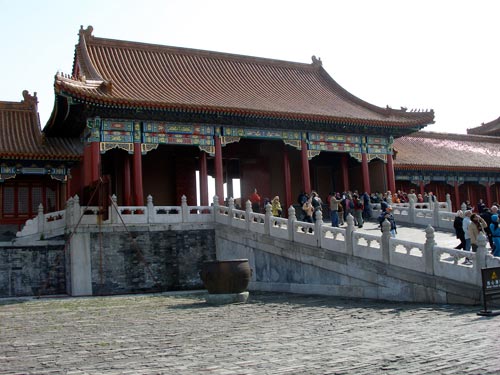
A glimpse back at the Gate of Moral Standards
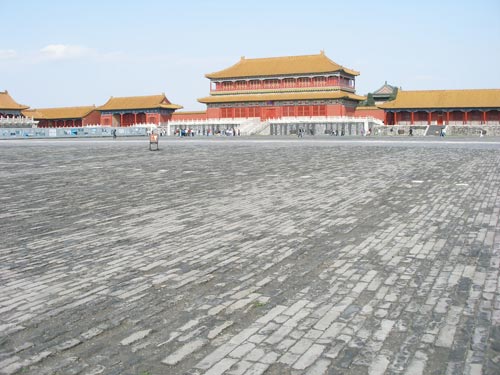
Looking to the east, over the Sea of Flagstones. The spacious square covers over 300,000 square feet.
In the side buildings are an array of museums.
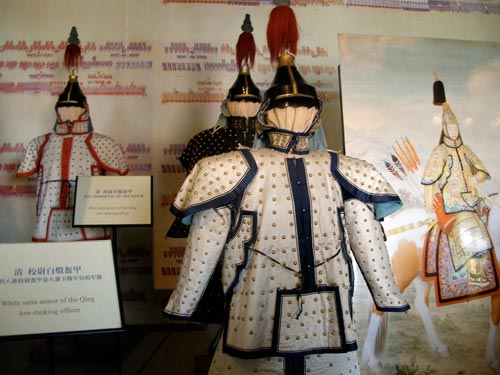
Examples of military attire

Various imperial musical instruments
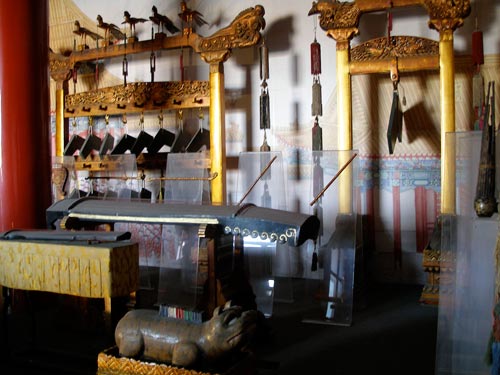
Chinese imperial roof decorations (roof charms or figures) were only allowed on official buildings of the empire. These were often made of glazed ceramic, and formed an outward marching procession. Here we see the imperial yellow glaze reserved for the emperor.
At the head of the procession is a man riding a Phoenix. At the end is an imperial dragon, representing the authority of the state. In between are an odd number of mythical beasts set to pounce upon the man and devour him should he stray from performing his duties with faithfulness and virtue. The number of beasts indicate the importance of the duties performed within the building or courtyard protected by a gate. The maximum number of beasts is nine.
Exiting the courtyard through a gate to the west of the Hall of Supreme Harmony, we continue our journey deeper into the city.
Preserving Harmony
This is the back part of the outer court.
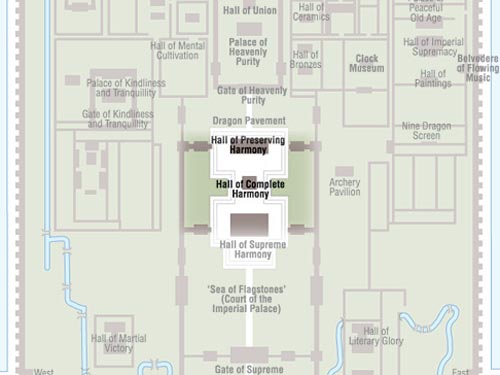
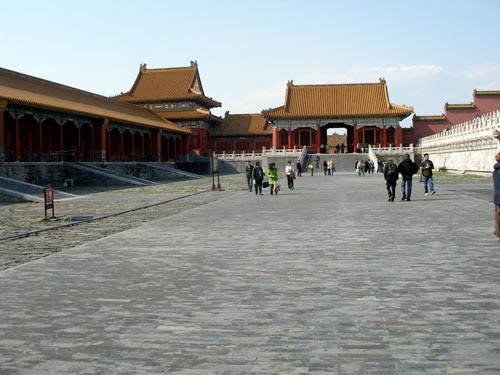
A corridor leads us along the west side of the two elevated halls.
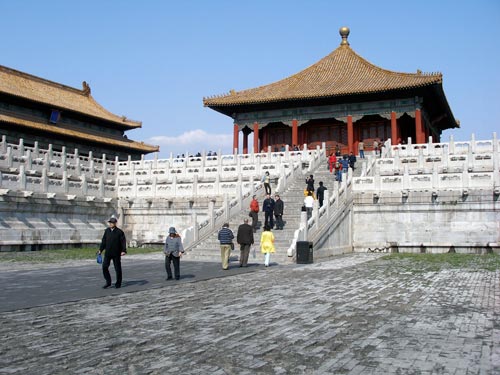
The Hall of Central Harmony (on the right)...
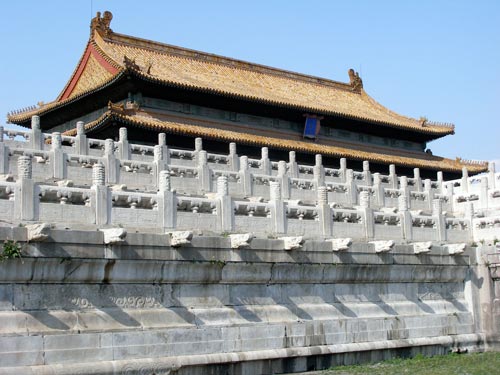
... and The Hall of Preserved Harmony
Bao He Dian (Hall of Preserved Harmony):
This hall was used for banquets and rehearsing ceremonies. It was also the site of the final stage of the imperial examinations that were held once every three years. 300 scholars came from all over the country to take exams that lasted three days and three nights. The three scholars with the best scores would get honorable titles and the privilige of riding a horse through the central doorways (the emperor's exclusive doorways) of the palace gates. The exams started in the Han Dynasty (206 BC - 220 AD) and served the purpose of recruiting Confucian scholars to be ministers and high officials. Later it was suspended but was resumed again in the Tang Dynasty and lasted until 1905.

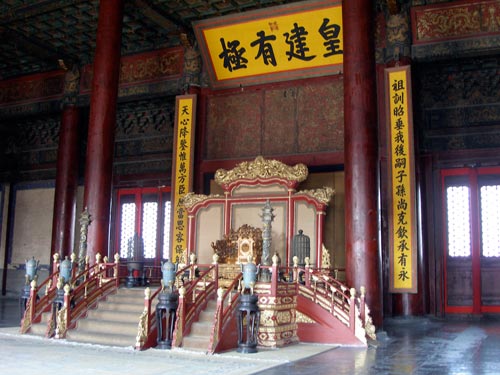
A small imperial throne
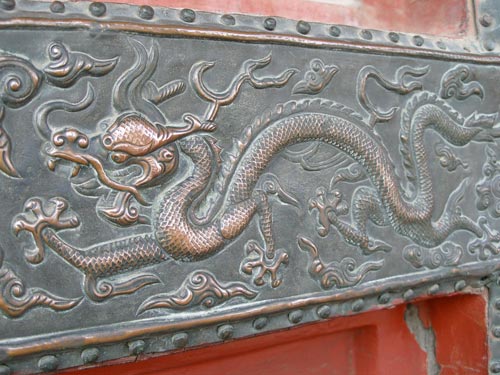
A fierce dragon decorates the wall.

The Hall of Preserved Harmony as seen from the Hall of Central Harmony
Zhong He Dian (Hall of Central or Complete Harmony):
This hall is smaller than the other two, and is square in shape. It was used by the emperor to prepare and rest before and during ceremonies. He consulted with his religious ministers here.
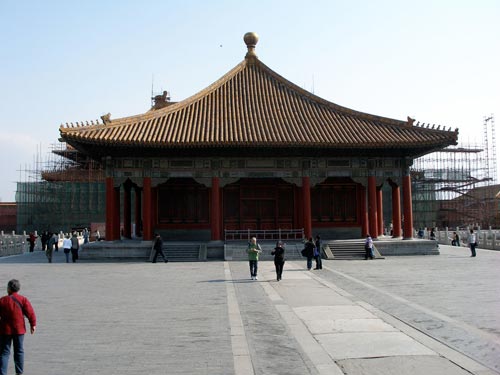
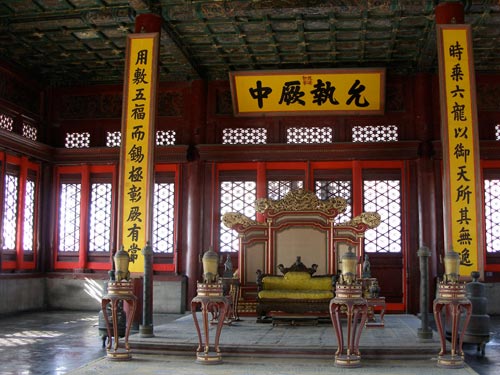
Inside the hall
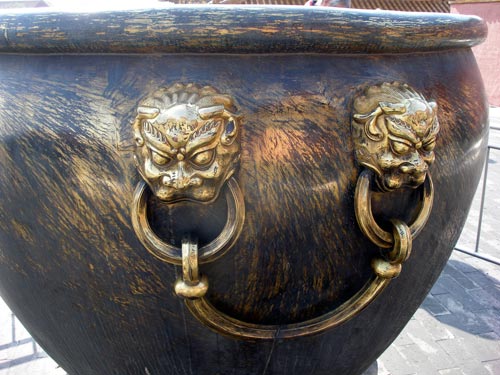
In the courtyard are several big cauldrons for storing water against fire. Once there were 308 in the palace but now only 231 remain. They are made of iron, bronze or gilded-bronze.
The terraces:
The three-level terraces are meant to symbolize the connection between heaven and earth. They represent earth (lowest level), man (middle) and heaven (highest). Therefore, humans must be carefully balanced between earth and heaven.

Looking northeast toward the archery pavillion...

... east...
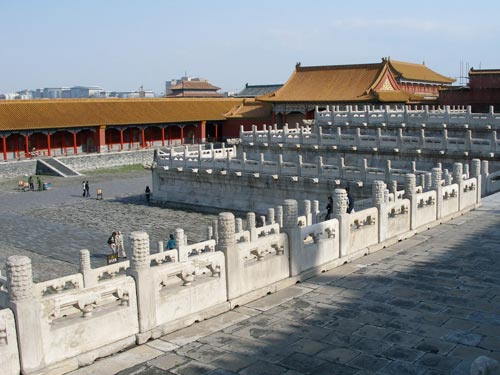
... and southeast
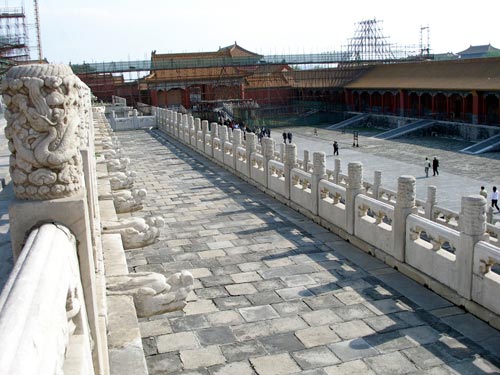
Looking back down the west side

A view from the upper terrace
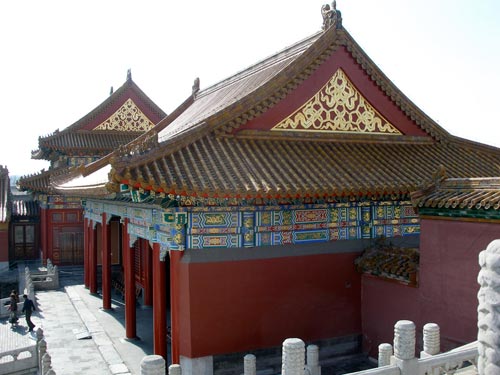
A gate on the west side
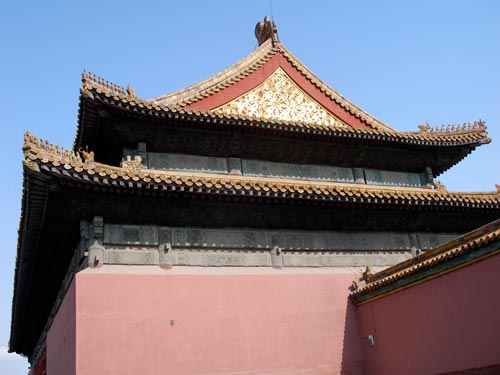
Walking around to the north side of the Hall of Preserved Harmony, on our way to the Imperial Residence
|
|

